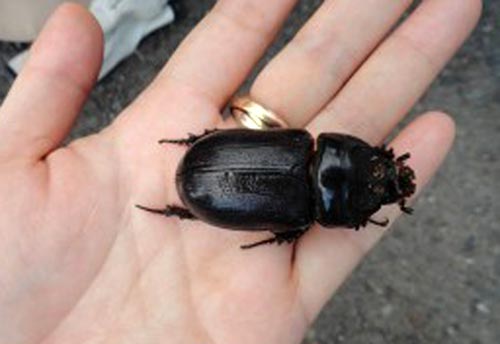
The Municipality of Rota is optimistic in containing the spread the CRB with continual support from the general public, federal partners, and the administration. Plans are in place for urgent public outreach to inform the public of the new sighting and seek their involvement to support the CRB Team’s efforts. The governor emphasized that we cannot do this alone and requires participation from the public as Rota fights this battle.Ĭollaboration with local landowners is critical to help solve this problem. Palacios are aware of the situation and stress the importance of addressing and containing the outbreak. Coconut rhinoceros beetle (CRB) is a devastating pest of the economically important coconut (Cocos nucifera L.).The female adult oviposits in and larvae feed on dead and decaying organic materials 1 6.The larval stage is 1115 weeks in length, and the pupal stage is about 6 weeks in length. Benavente is exploring other methodologies and strategies in communication with USDA Guam and University of Guam. He appreciates the immediate and proactive response from the Municipality of Rota to continue eradication efforts at the newly identified area. Lands and Natural Resources Secretary Anthony Benavente met with Atalig and Invasive Species coordinator Frank LG Aldan to develop preventative measures for the CRB reaching Tinian and Saipan. Atalig expressed the urgency of the matter to heighten aggressive eradication management before matters go out of control. Atalig to declare a State of Significant Emergency regarding the CRB due to the impact on Rota’s agriculture. This new site is four miles from the original CRB containment areas, Tweksberry Beach Park and Papau (Liyo). Calvo reported the following CRB findings: 250 unaged grubs, 411 instars, 27 adult males, and 40 adult females. It has been suggested that this resurgence is related to an O. This invasive pest is native to Southeast Asia.

The Municipality of Rota is optimistic in containing the spread of the CRB with continual support from the general public, federal partners, and the administration.The areas of concern are Talakhaya, Gagani, Poña Point, Gu’a, and along the Oggog stream, which comprises an area of 978,749 square meters. Incursions of the Coconut rhinoceros beetle (CRB), Oryctes rhinoceros, have been detected in several countries of the south west Pacific in recent years, resulting in an expansion of the pest’s geographic range. The Coconut Rhinoceros Beetle (Oryctes rhinoceros)was first detected in Hawaii in December 2013. LEARN MORE Please report any coconut rhinoceros beetles, larvae, tree damage, or fallen traps to the CRB Response. Adults are about 2' in size, and larvae grow to 3.5 - 4' before pupating. The Governor emphasized that we cannot do this alone and requires participation from the public as Rota fights this battle.Ĭollaboration with local landowners is critical to help solve this problem. Coconut rhinoceros beetles (CRB) or Oryctes rhinoceros, native to Southeast Asia, are a threat to palm species outside of their native range. Palacios were made aware of the situation and stress the importance of addressing and containing the outbreak. Secretary Benavente is exploring other methodologies and strategies in communication with USDA Guam and University of Guam. Secretary of Lands and Natural Resources Anthony Benavente met with Mayor Atalig and the Invasive Species Coordinator Frank LG Aldan, to develop preventative measures for the CRB reaching Tinian and Saipan. Mayor Atalig expressed the urgency on the matter to heighten aggressive eradication management before matters become out of control. Atalig, to declare a State of Significant Emergency regarding the CRB due to the impact on Rota’s agriculture. This has prompted the Mayor of Rota Efraim M. The areas of concern are Talakhaya, Gagani, Poña Point, Gu’a, and along the Oggog stream, which comprises of 978,749 square meters.

Volunteers throughout the week, from the Department of Fire and Emergency Medical Services and from the Department of Community and Cultural Affairs, assisted the CRB team with this pressing matter. On the following day Sunday, September 13, 2020, the CRB team immediately began dissecting trees, setting traps, and logging CRB findings. Decaying coconut trees and scissor cuts on the palm leaves were spotted via drone. Manglona, reported to the scene and confirmed the CRB infestation through drone surveying. On Saturday, Septemthe Department of Lands and Natural Resources (DLNR) received a critical tip regarding possible infestation of the coconut rhinoceros beetles (CRB) in the Gagani and Talakhaya areas of Rota.ĬRB Field Supervisor Mark C.


 0 kommentar(er)
0 kommentar(er)
